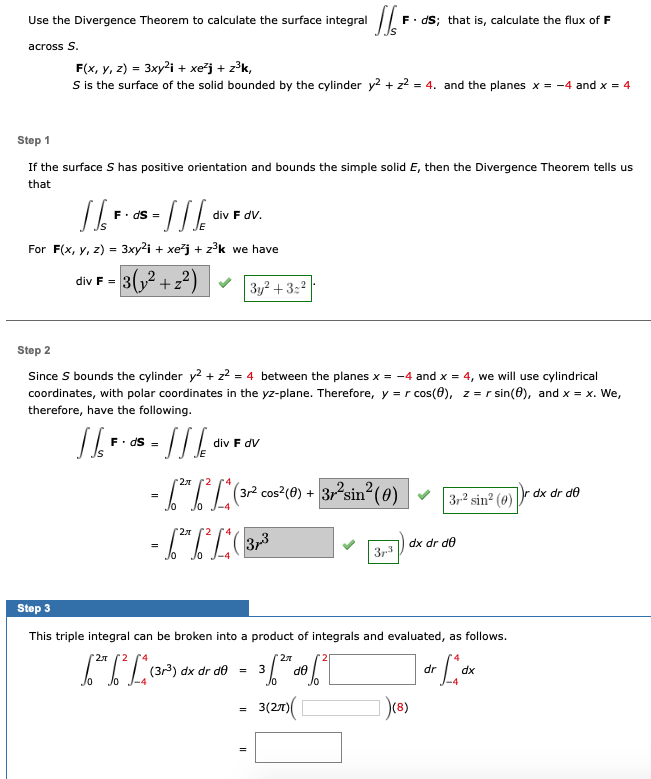Calculus: Early Transcendentals
8th Edition
ISBN:9781285741550
Author:James Stewart
Publisher:James Stewart
Chapter1: Functions And Models
Section: Chapter Questions
Problem 1RCC: (a) What is a function? What are its domain and range? (b) What is the graph of a function? (c) How...
Related questions
Concept explainers
Equations and Inequations
Equations and inequalities describe the relationship between two mathematical expressions.
Linear Functions
A linear function can just be a constant, or it can be the constant multiplied with the variable like x or y. If the variables are of the form, x2, x1/2 or y2 it is not linear. The exponent over the variables should always be 1.
Question
Solve Step 3

Transcribed Image Text:Use the Divergence Theorem to calculate the surface integral
F. dS; that is, calculate the flux of F
across S.
F(x, y, 2) = 3xy?i + xej + z°k,
S is the surface of the solid bounded by the cylinder y? + z? = 4. and the planes x = -4 and x = 4
Step 1
If the surface S has positive orientation and bounds the simple solid E, then the Divergence Theorem tells us
that
F. ds =
div F dV.
For F(x, y, z) = 3xy?i + xej + z³k we have
3(,2 + z²)
div F =
3y2 + 3:2
Step 2
Since S bounds the cylinder y2 + z2 = 4 between the planes x = -4 and x = 4, we will use cylindrical
coordinates, with polar coordinates in the yz-plane. Therefore, y = r cos(0), z = r sin(8), and x = x. We,
therefore, have the following.
F. dS =
div F dV
2
(3r2 cos?(0) + 3,2sin?(
?(0)
dx dr de
3,2 sin² (0) |
-4
3p3
dx dr de
3p.3
Step 3
This triple integral can be broken into a product of integrals and evaluated, as follows.
27 (2
27
3
de
dr
dx
Jo
3(27)(
Expert Solution
This question has been solved!
Explore an expertly crafted, step-by-step solution for a thorough understanding of key concepts.
This is a popular solution!
Trending now
This is a popular solution!
Step by step
Solved in 2 steps with 1 images

Knowledge Booster
Learn more about
Need a deep-dive on the concept behind this application? Look no further. Learn more about this topic, calculus and related others by exploring similar questions and additional content below.Recommended textbooks for you

Calculus: Early Transcendentals
Calculus
ISBN:
9781285741550
Author:
James Stewart
Publisher:
Cengage Learning

Thomas' Calculus (14th Edition)
Calculus
ISBN:
9780134438986
Author:
Joel R. Hass, Christopher E. Heil, Maurice D. Weir
Publisher:
PEARSON

Calculus: Early Transcendentals (3rd Edition)
Calculus
ISBN:
9780134763644
Author:
William L. Briggs, Lyle Cochran, Bernard Gillett, Eric Schulz
Publisher:
PEARSON

Calculus: Early Transcendentals
Calculus
ISBN:
9781285741550
Author:
James Stewart
Publisher:
Cengage Learning

Thomas' Calculus (14th Edition)
Calculus
ISBN:
9780134438986
Author:
Joel R. Hass, Christopher E. Heil, Maurice D. Weir
Publisher:
PEARSON

Calculus: Early Transcendentals (3rd Edition)
Calculus
ISBN:
9780134763644
Author:
William L. Briggs, Lyle Cochran, Bernard Gillett, Eric Schulz
Publisher:
PEARSON

Calculus: Early Transcendentals
Calculus
ISBN:
9781319050740
Author:
Jon Rogawski, Colin Adams, Robert Franzosa
Publisher:
W. H. Freeman


Calculus: Early Transcendental Functions
Calculus
ISBN:
9781337552516
Author:
Ron Larson, Bruce H. Edwards
Publisher:
Cengage Learning